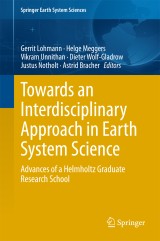Details

Towards an Interdisciplinary Approach in Earth System Science
Advances of a Helmholtz Graduate Research SchoolSpringer Earth System Sciences
|
53,49 € |
|
| Verlag: | Springer |
| Format: | |
| Veröffentl.: | 20.01.2015 |
| ISBN/EAN: | 9783319138657 |
| Sprache: | englisch |
Dieses eBook enthält ein Wasserzeichen.
Beschreibungen
This book describes the latest advances at the Helmholtz “Earth System Science Research School” where scientists from the Alfred Wegener Institute in Bremerhaven, the University of Bremen, and the Jacobs University are involved in research.<br>One of the greatest challenges is understanding ongoing environmental changes. The longer the time scale the more components of the Earth system are involved, e.g. interannual and decadal variations are related to the coupled atmosphere-ocean-sea ice system, whereas longer variations like glacial-interglacial or Cenozoic transitions involve the carbon cycle, ice sheets and gateways. In order to get deep insights into Earth system science, observations, remote sensing, past environmental data, as well as modeling need to be integrated. These different approaches are traditionally taught in separated disciplines at bachelor and master levels. It is, therefore, necessary to bring these disciplines together in PhD programs.<br>
<p>1 Earth System Science - past experiences and future trends.-<br>2 The educational program of the Earth System Science Research School (ESSReS).- 3 Time evolution of a PhD student's mood - A review of my time as PhD student in the research school ESSReS.- 4 Progress in Earth System Science: What does it take to make our ideas clear.- 5 Towards a better tropospheric<br />ozone product from SCIAMACHY: improvements in high latitude stratospheric ozone.- 6 Ten-year SCIAMACHY Stratospheric Aerosol data record: Signature of the Secondary Meridional Circulation associated with the Quasi-Biennial Oscillation in the Tropical Stratosphere.- 7 Investigating the link between glyoxal and biogenic activities.- 8 Estimates of NOx emission factors from GOME-2 measurements for the major types of open biomass burning.- 9 The use of FTIR-spectrometry in combination with different biosphere-atmosphere flux measurement techniques.- 10 Near-infrared lunar absorption spectroscopy for the retrieval of column averaged CO2 and CH4.- 11 A new method to filter out radio-frequency interference (RFI) from SMOS level 1C data for sea ice applications.- 12 Arctic Multiyear Ice Concentration Retrieval from SSM/I data using the NASA Team algorithm with dynamic tie points.- 13 Detecting CDOM fluorescence using high spectrally resolved satellite data: a model study.- 14 The flow of dense water plumes in the western Weddell Sea simulated with the Finite Element Ocean Model (FEOM).- 15 Data analysis and modeling of the Amundsen Sea embayment.- 16 Impact of sea-ice bottom topography on the Ekman pumping.- 17 Classification of CryoSat-2 radar echoes.- 18 Integration of passive tracers in a three-dimensional ice sheet model.- 19 Bivalve shells – unique high-resolution archives of environmental past.- 20 Functional diversity and traits assembly patterns of benthic macrofaunal communities in the southern North Sea.- 21 Snow accumulation in North Greenland over the last millennium.- 22 Seismostratigraphic analysis and glacial history of the Weddell Sea region, Antarctica.- 23 Visual analysis of Relevant Fields in Geoscientific Multifield Data.- 24 A Database Language Suitable for the Earth System Sciences.- 25 Towards Collaborative Exploration and Analysis of Big Data from Mars: A Noachis Terra Case Study.</p>
<p>This book describes the latest advances at the Helmholtz “Earth System Science Research School” where scientists from the Alfred Wegener Institute in Bremerhaven, the University of Bremen, and the Jacobs University are involved in research.<br>One of the greatest challenges is understanding ongoing environmental changes. The longer the time scale the more components of the Earth system are involved, e.g. interannual and decadal variations are related to the coupled atmosphere-ocean-sea ice system, whereas longer variations like glacial-interglacial or Cenozoic transitions involve the carbon cycle, ice sheets and gateways. In order to get deep insights into Earth system science, observations, remote sensing, past environmental data, as well as modeling need to be integrated. These different approaches are traditionally taught in separated disciplines at bachelor and master levels. It is, therefore, necessary to bring these disciplines together in PhD programs. <br></p>
Shows the spectrum of Earth system science: remote sensing, data exploration, process understanding, modeling, and informatics Provides examples of how to link the different disciplines as a key concept of future PhD education in Earth system science Links ‘data and modeling’ to enable graduate students from a variety of disciplines to cooperate and exchange views on the common theme of global environmental change Includes supplementary material: sn.pub/extras

















